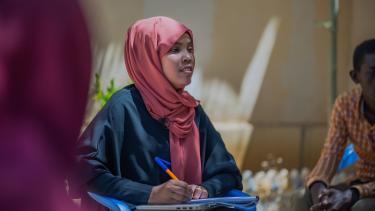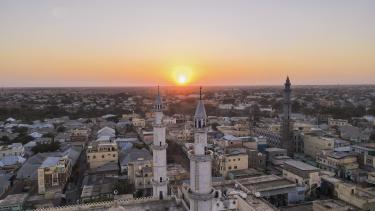
An elderly man in a Somali livestock market. Photo: Said Fadhaye/UNDP Somalia
With 69 percent of its 16 million people living below the poverty line, Somalia is one of the poorest nations in Africa and the world. Due to its arid landmass, degraded habitats, and protracted conflict, the country also ranks the highest in terms of climate vulnerability among fragile states in the world.
Despite inconsequential historic greenhouse gas emissions (representing less than 0.09 percent of total global emissions), climate models show that Somalia could see mean temperatures increase between 3°C and 4°C by 2080.
This is bound to have devastating effects as the Somali economy is largely agrarian and dependent on food exports. Between 60 and 70 percent of the population are pastoralists, herding livestock – camels, cattle, goats, and sheep – as their primary occupation. Another 15 percent are practicing agriculture. As temperatures rise, shortages of arable lands, pastures, and water will expose millions to famine, extreme poverty, and violent conflict.
Ahead of last year’s COP26, Somalia revised its Nationally Determined Contribution (NDC), with support from UNDP’s Climate Promise. Despite its fragile context, the country raised ambition on both mitigation and adaptation measures, aiming to reduce greenhouse gas emissions by 30 percent compared to business-as-usual, strengthen adaptation and disaster preparedness in vulnerable sectors, and invest in climate-resilient development.
Many of the commitments in the NDC are building on the work that Somalia has been doing over the years with UNDP in areas like energy, water, climate security, and gender equality. Below are some examples of the support providing a solid foundation for Somalia’s path to a resilient future.

Local residents sit under an array of solar panels used to help pump water from the dam in Shaxda village, Puntland. Photo: Tobin Jones/UNDP Somalia
Finding new energy sources
Access to energy remains low across Somalia, significantly below regional and global averages. Nearly 11 million people lack access to electricity. Having no other choice, many remain dependent on traditional biomass, which accounts for 80 to 90 percent of energy needs.
Charcoal production remains widespread, both for internal use and exports, despite a national ban. This damaging practice leads to high deforestation rates – only 10.5 percent of the country remains covered in forests, with 35,000 hectares being lost each year – as well as scarcity of fresh water, severe erosion, and land degradation. These effects further increase the vulnerability of communities across the country to climate change and threaten their livelihoods.
Part of the solution is to provide clean energy solutions for households and businesses and promote alternative sources of income for people depending on charcoal production. In addition, building institutional capacities for sound environmental management and developing a strong policy framework to promote private sector-led clean energy options are crucial in managing the much-needed energy transition.

Fardosa Mohamed, a 50-year-old pastoralist, washes clothes at home using water she’s collected from the UNDP-funded dam in Baligubadle. Photo: UNDP Somalia
Conserving water and protecting livelihoods
Water is very precious in Somalia’s overwhelmingly arid and semi-arid landmass. Only 30 percent of the population has access to clean water. In rural areas, local communities manage the water supply and irrigation systems. Despite their crucial role, most of the time, they face challenges due to lack of financial resources and expertise to plan, operate, and maintain water infrastructure.
For the past few years, the country has been experiencing frequent cycles of intense droughts and floods. As a result, groundwater and shallow water reservoirs are increasingly stressed. Adapting to the accelerating impacts of the climate crisis requires that every drop of water be effectively allocated and utilized.
Trainings provided by UNDP for public officials and representatives from local communities around the country are supporting the country to apply more efficient, equitable and integrated approaches to water resources management. At the same time, new programmes provide early warnings about extreme events to vulnerable groups, including 350,000 pastoralists, and increase their resilience to droughts and floods through water collection and diversion.

Khowla Mohamed, coordinator of the UNDP-supported Alternative Dispute Resolution Centre in Baidoa, Somalia. Photo: Said Fadheye/UNDP Somalia
Climate action as a security issue
Somalia’s energy and water problems are happening against the backdrop of ongoing conflict, meaning the country must deal with the dual burden of climate change and violence. Often, these two crises mutually reinforce each other as armed groups sometimes willfully destroy water, food, and energy sources, while competition over increasingly scarce resources further fuels divisions and conflict.
Youth are a key demographic. Two out of three young people in Somalia live in poverty. Over half are acutely food insecure and many are internally displaced. Youth groups and NGOs are engaged in peaceful forms of activism and community development, including environmental education, but their effective participation in formal processes remains limited.
Tackling climate action and conflict prevention together by climate-proofing peacebuilding initiatives, strengthening institutions and the rule of law, and promoting inclusive governance are some of the long-term solutions that Somalia needs. In the short-term, local climate security action plans are providing opportunities for internally displaced persons, women, and youth to prevent conflict and strengthen climate resilience and adaptation.

A lawyer speaks with her client during a free legal aid clinic, part of a UNDP funded programme, in Garowe, Puntland. Photo: Tobin Jones/UNDP Somalia
Women at the negotiating table
Somalia’s development is hampered by extreme gender inequality. Women in Somalia continue to face discriminatory family laws and have very poor access to resources and services, which in turn makes them more vulnerable to the dual impacts of the climate crisis and conflict.
Despite women bearing heavy household responsibilities, they are largely excluded from decision-making processes, from the household level all the way to the national level. Recurrent droughts and conflicts have resulted in a growing number of single women-headed households and it is clear that climate action cannot be done without them.
If climate resilience is to be achieved, changing social norms and laws about women’s role in Somali society must be one of the first priorities. Giving women access to decision-making processes and the tools to adapt to the impacts of the climate crisis is crucial to not only improving their lives, but also their roles in managing local water and energy resources and conflict resolution.

Aerial view of Somalia's capital, Mogadishu. Photo: Said Fadhaye/UNDP Somalia
Only one path forward
In recent years, Somalia has done a lot of work to carve a resilient path forward. The country’s revised NDC is proof of its ambition to ensure the future is hopeful instead of bleak. But given the magnitude of the challenge and the urgency to implement solutions, financial support from the international community is critical to success.
There is a lot of room for investment. Somalia is blessed with high levels of solar and wind energy resources and has good potential for water conservation and water harvesting. As a new federal state with a bustling young population, it has the option to pursue peaceful, climate-resilient development that promotes women’s rights and economic prosperity.
And while risks exist, more work needs to be done to ensure climate finance is less risk adverse and can reach the most vulnerable groups, defying the trends identified by recent research showing that the most fragile countries receive the least support.
The adaptation component of Somalia’s updated NDC, which also recognizes mitigation co-benefits, is estimated to require USD 5.55 billion per year from 2021 to 2030. Failing to meet that would put millions of people at risk. The only path forward is one of international cooperation and solidarity, with the most fragile states like Somalia at the center.
***
Climate Promise supports 120 countries – including 40 least developed countries, 28 small island developing states, and 14 high emitters – to enhance their Nationally Determined Contributions under the global Paris Agreement. Delivered in collaboration with a wide variety of partners, it is the world’s largest offer of support for the enhancement of climate pledges.